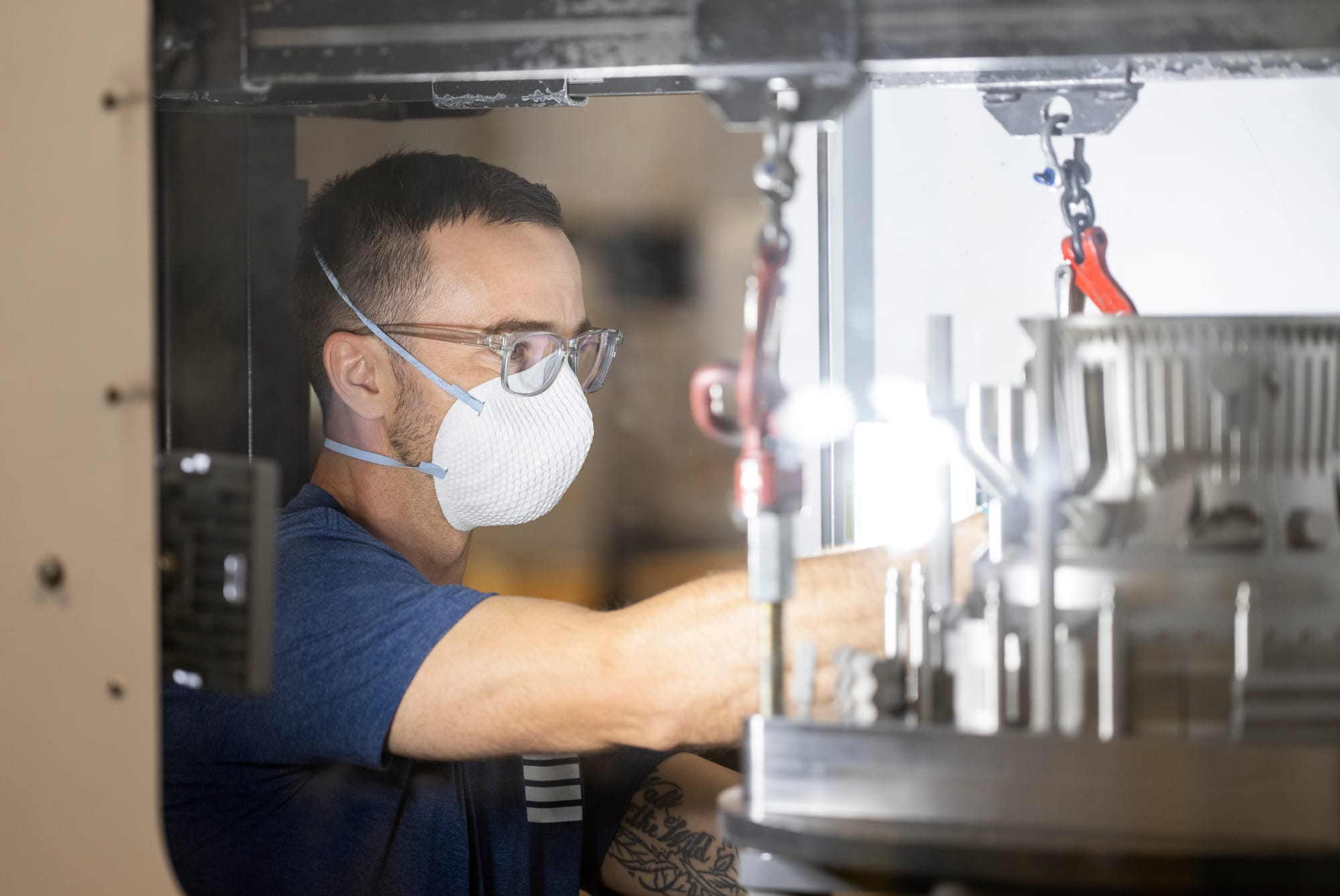Building a U.S.-based Supply Chain with Additive Manufacturing
Additive manufacturing’s edge is more than speed.

Ask Darius Ehteshami, Beehive Industries’ Chief Operating Officer, what the company is striving for and he’ll give you a straight answer. Beehive is building a new class of jet engines that reap the benefits of additive manufacturing and streamline efficiencies throughout the supply chain.
For Ehteshami, the Beehive model offers advantages that, combined, result in a best-in-class jet engine at a best-in-class price. We sat down with him to learn more about the innovation underway at Beehive and the company’s vision for a stronger U.S.-based supply chain.
Does Beehive’s jet engine differ from traditionally manufactured jet engines?
Beehive’s jet engine is designed and engineered for additive manufacturing; it’s significantly different from a traditionally manufactured engine. You couldn’t build it with conventional castings and forgings.
It’s a 3D-printed jet engine, fabricated with metallic powders such as nickel alloys, aluminum, and titanium, as well as new superalloys developed by Beehive. It also has considerably fewer parts than a traditionally manufactured engine. More than 90% of each engine can be manufactured in-house, in the U.S., at one of our three manufacturing facilities.
Beehive has also integrated design and manufacturing. Our teams work closely together and collaborate alongside each other. This is a key difference. Most manufacturers or OEMs spread design and manufacturing across dozens of teams and suppliers that rarely interact.
Bear in mind that conventional jet engine manufacturers are almost always OEMs. They’re integrators. They manufacture engines with parts and components made by suppliers and partners from around the world. They rely on a complicated supply chain and outsourcing.
Lastly, there’s always a margin added by OEM suppliers. There are many layers within the supply chain: Tier 2, Tier 2 and Tier 3 suppliers. This adds up from both a financial and time perspective, with a domino effect of delays and cost overruns. Suppliers also tend to overcompensate, so the result is overproduction. It’s an antiquated approach: paying for extra layers of product that you will never use.
What are the risks of the current OEM supply chain?
There’s significant risk inherent in today's OEM supply chain, including delays and cost overruns, as well as security threats due to goods and services that are manufactured in dozens of countries. It’s compounded by other factors, such as labor disruptions, materials shortages, and weather and transportation delays, not to mention events like the pandemic.
When almost all parts are designed or owned by a subcontractor, procurement becomes a highly complex global movement of goods. The potential for missteps is deep.
By contrast, Beehive’s additive manufacturing process removes much of the risk of outsourcing production while also conferring other benefits. For example, we have significantly less complexity in procuring powder. It’s dramatically easier to source and manufacture with powder when the source is close at hand on U.S. soil.
But while additive manufacturing is a highly viable option for companies looking to reduce supply chain risk, there are even greater benefits of additive.
Designs, superalloys, and cost-reduction
In addition to speed-to-market, additive manufacturing can also reduce costs. For example, additive offers the ability to avoid significant investment in CAPEX (capital expenditure or capital expense) or "tooling" that requires a long tail of payback (ie. volume). It also offers the capacity to design, manufacture and rapidly iterate until you arrive at the final specs.
Additive reduces your development cycle because it increases speed and productivity. Ultimately, it reduces the cost required to bring new products to market. Consider how the following could impact the manufacturing process with additive:
- The option to print designs that can’t be manufactured with castings and forgings;
- The ability to use new superalloys, which offer better capabilities and durability. These superalloys can sustain higher temperatures, which equals higher efficiencies that extend jet engine range and performance;
- A significant reduction in the number of parts, which reduces maintenance costs;
- The use of one machine versus many in the manufacturing process.
However, the greatest benefit of Beehive’s additive manufacturing model is the integration of our design, engineering and manufacturing teams. It’s a highly collaborative and new approach to jet engine manufacturing that offers room for innovation and new approaches.
Walk us through Beehive’s integration of design, engineering and manufacturing.
At Beehive, we’re not locked into a way of doing things, building off an old plan.
We’re developing a new class of jet engines based on additive manufacturing, without any of the constraints of castings and forgings. Our starting point is virtually limitless.
The Beehive design process begins with powder, and offers engineers much more scope and potential for design. Our manufacturing team sits in the design process up front and we can test geometries and part concepts, and give that feedback to our engineers before they have even finalized their design.
Beehive can fit a customized engine inside your vehicle. Your aircraft is no longer designed around an engine, which dramatically changes your options.
Beehive brings design, engineering, and manufacturing in-house, which provides an almost instant feedback loop during the research and development process. There’s no outsourcing, which dramatically reduces the risk of delays. We use a small number of machines—compared to a foundry, which is a complex, capital-intensive enterprise. Again, that reduces risk.
With additive, we have the advantage of teams running ahead to determine how we can build what a customer wants. The feedback is ongoing, and fast. We can also print samples and conduct ongoing testing without delays.
Lastly, additive manufacturing is forward deployable. It’s modular. With the availability of printers and powder, it’s possible to shift manufacturing locations rather than relying on shipping and transportation from a single manufacturing facility.
Are there constraints in the process?
Additive manufacturing is a highly technical process; it's chemistry and metallurgy, which requires a specialized workforce. Like all manufacturers, we need a talent pipeline. That pipeline is already growing alongside the additive industry.
Additive manufacturing may also be slightly constrained due to the scale of today’s printers. Just as some materials aren’t suited for castings and forgings, some materials are not yet printable. This is why Beehive develops new superalloys exclusively for additive. And bear in mind that even though multi-laser additive manufacturing is a faster process, some parts can take up to 150 hours. It’s all relative.
Lastly, I would be remiss if I didn’t mention FAA certification. This is required for all manufacturers. However, in the case of Beehive’s jet engines, the requirements are markedly different as our engine is developed exclusively for unmanned aircraft rather than commercial aircraft. Unmanned aircraft, whether categorized as expendable, attritable, or exquisite, must be built affordably to allow for a margin of risk and loss compared to manned aircraft. To be considered for these applications, engines and aircraft must be produced at considerably lower cost and in sufficient quantities to ensure operational capabilities.
How does additive manufacturing impact speed-to-market?
Additive manufacturing offers a speed advantage on several fronts. What a traditional OEM could produce in nine to 12 months, Beehive can produce in 6 weeks (including 14 days in heat treatment).
In engine manufacturing, there are several milestones you need to reach, and additive gets you there faster. For example, FETT, or First Engine to Test, is a phase in which you lock in design, usually at the 1.5-to-2 year mark using traditional manufacturing methods. As a result, it can take 3–5 years to determine a design error. When an error occurs, it’s a major setback. By contrast, additive can cut 2 years off that timeline.
Many traditional engine manufacturers opt to refine existing designs rather than start fresh. For engineers, that means you’re constantly trying to improve an older design. You’re working with what you have. It’s simply cheaper than starting over. But the knock-on effect is a product that’s less optimized and more expensive.
At Beehive, the design process is in lockstep with manufacturing because we have the capacity to continually test and refine. As a customer, you get a bespoke solution in half the time. Beehive goes from concept to test in 12 months versus 3–5 years. You get scalable, best-in-class performance at half the cost. And, it’s all designed and manufactured in the U.S.
How is additive manufacturing anticipated to grow?
We’re seeing an increasing demand for bespoke solutions as well as collaboration from a range of sectors and industries. Customers want to partner with us to test and explore the potential for additive manufacturing, and develop new superalloys. They see the benefits of designing for additive—designing for powder—and the opportunity to manufacture right in their own backyards, in the U.S.
With a feedback loop that’s almost real-time, customers value the opportunity to continuously improve design without incurring significant costs. It’s this flexibility, combined with speed-to-market, cost-savings, a U.S.-based supply chain, and the potential for endless design that’s accelerating the adoption of additive. As the industry grows, I anticipate we’ll see increasing demand for large format, multi-laser, multi-material additive manufacturing in aerospace, heavy industry and the energy sector, in particular.
